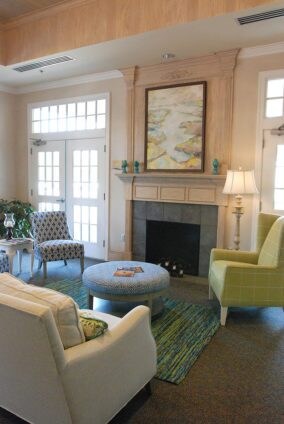Johnston Health Foundation undertakes makeover at SECU Hospice House

During the last few months at the SECU Hospice House, an artist has been hard at work. With the walls, ceilings and furniture as his canvas, William Strickland has added decorative touches that delight and make you look twice.
Are those real wood planks above the fireplace? Could those stripes and textures in the dining room be wallpaper? Is that wall behind the nurses station made of natural stone?
Strickland, who has worked mostly with commercial and residential clients the last 29 years, says he pulled tricks from his interior-decorating bag to soften and brighten the environment, and to draw attention to architectural features, such as the trey ceilings in the lobby, dining room and hallways. All now have bold, modern light fixtures that command attention.
“Medical settings tend to have a lot of hard surfaces such as plastic, Formica, stainless steel,” he says. “To give the space a more residential feel, we used a few decorating tricks to counter things we couldn’t change.”
A committee of staff, volunteers and members of the Johnston Health Foundation board of directors helped define the scope of work, and gave Strickland feedback as he offered ideas and suggestions for change.
The foundation paid for the project from funds in the hospice house capital campaign. The house opened to patients in June, 2010.
Wanda Johnson, coordinator of the hospice volunteers, says the staff and families love and appreciate the makeover, which includes colorful furnishings in the front lobby and family room, and two large dining-room tables that accommodate families and encourage solo visitors to eat with one another.
Original, local artwork was also added to the common areas, and ceiling fans in patient rooms.
Johnson says Strickland’s artistry turned into a pleasant diversion for families and patients. “I think they enjoyed watching his progress and liked asking him about his craft,” she says. “He has a way, too, of connecting with those he meets. I’m trying to recruit him as a volunteer.”

During his stint, Strickland learned how hospice works and enjoyed talking with the staff about their roles. “I could feel the compassion that nurses, volunteers and housekeepers have for patients and their families,” he says. “It’s a different place because of that.”
Strickland says his goal was to make the hospice house pretty.
“The hospice house is a place for the living,” he says. “Patients still need joy in their lives, whether it’s gazing out on a sunny day, having family come by, or appreciating the colors in a beautiful work of art.”